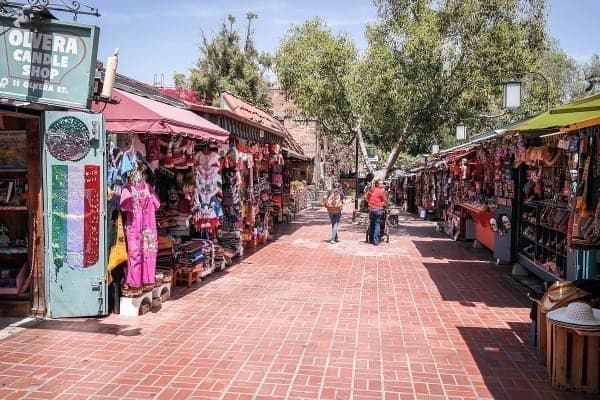Before the traffic and highways, before the movie studios and fancy shops and restaurants, before anything that would really identify the city as what it is today, Los Angeles was a small village known to its inhabitants as El Pueblo de Nuestra Señora la Reina de los Angeles del Rio de Porciuncula (The Village of Our Lady, Queen of the Angels of the River Porciuncula).
A sleepy little town

It was a tiny settlement of Spanish settlers founded in the area not far from where the 60, 5, 101, and 710 freeways converge. The area remained under Spanish rule until Mexico’s independence (not May 5th) and became part of these United States in 1848. Los Angeles was a sleepy little town with some farm land and cattle ranches, but was not a commercial center. The city lacks a natural port, mineral or fuel reserves, steady rain or irrigation, or anything that makes a major city like New York, San Francisco or Chicago.
The city was mostly built on advertising hype and promises of sunshine- for a great look at how Los Angeles was “made” read Carey McWilliams’ Southern California: An Island on the Land. But before the great influx of so many diverse peoples and cultures, before the railroads and the cars brought people from all over, it was a small gathering of adobe buildings, a church, and a red brick plaza. Remnants of this land before America still exist in the heart Downtown Los Angeles at Olvera Street, the oldest street in the city.
It was Wine Street
As the city grew into the 20th century and the focus was on modernization and growth, Olvera Street, originally known as Wine Street (or Vine Street), fell into disrepair and became, at best, a dirt alley the hidden and neglected in the towering shadows of progress. During this time thousands of people were running towards the American Dream from all over the world and for most Mexicans the destination was Los Angeles.
There would be no Olvera Street today if not for the efforts of Christine Sterling, a wealthy socialite from San Francisco who was residing in the Chavez Ravine area. There were plans for the area to be razed when she took notice of the area in 1926. The place was dark and dirty and home to the element of society that seeks out dark and dirty places. But beneath the dank and din she noticed the Plaza Church that had been built in 1822.
She also must have realized that the ancient adobe structure in the center was the home of Francisco Avila, a wealthy ranchero and one-time mayor of Los Angeles. His home was built in 1818 making that particular building the oldest residence within the city limits. Miss Sterling recognized what the street would have been in its heyday realized what a shame it would be to have the oldest and possibly most culturally significant part of the city torn down.
The savior of Olvera Street
Having the money and connections to get real results one can say that she single handedly saved Olvera Street from Los Angeles. She got word to Harry Chandler, who ran the LA Times, got up in front of the City Council, and even managed to get prison inmates to assist with the project. Sterling envisioned a thriving marketplace that would be a romantic cultural center for Mexican and Los Angeleno history. And she was right.
In the end the entire marketplace was rebuilt into a thriving Mexican American marketplace. She even lived in the Francisco Avila Adobe house up until her death in 1963. Today it is designated as a Historic Landmark.
Some of my fondest childhood memories come from when my parents would take my brother and I along to a particular restaurant called La Luz del Dia where we would climb the staircase along side the kitchen where we would peer over the railing to watch the women clap balls of masa between their palms to make the delicious tortillas that accompany every dish. Olvera Street has some of the best taquitos, champurrado, tamales, menudo… you name it, you’ll find it- and it will be pretty tasty. There are shops of all kinds from candles and cheap toys to leather goods and candy stores. There are frequent tours, shows, lectures, and events being held all the time.
My own memories of Olvera Street
When I was in grade school I remember our class went on a field trip to Olvera Street by train. We took the train from the Fullerton Train Station to Union Station just across the street from Olvera. It was fun at the time but now that I’m older I realize that my school is much closer to Los Angeles than it is to Fullerton but I guess it was just part of the experience.
A couple of other fantastic places to visit near the antique alley are Philippe’s, the home of the French Dip Sandwich (watch out for the hot mustard), the aforementioned Union Train Station, The Museum of Contemporary Art is nearby, as are numerous theaters and concert halls like the Disney Concert Hall. Amid all the hustle and bustle, the offices and cars and museums and everything else going on at such a fast pace all around Los Angeles, everyone should make at least one pilgrimage to see where it all started.